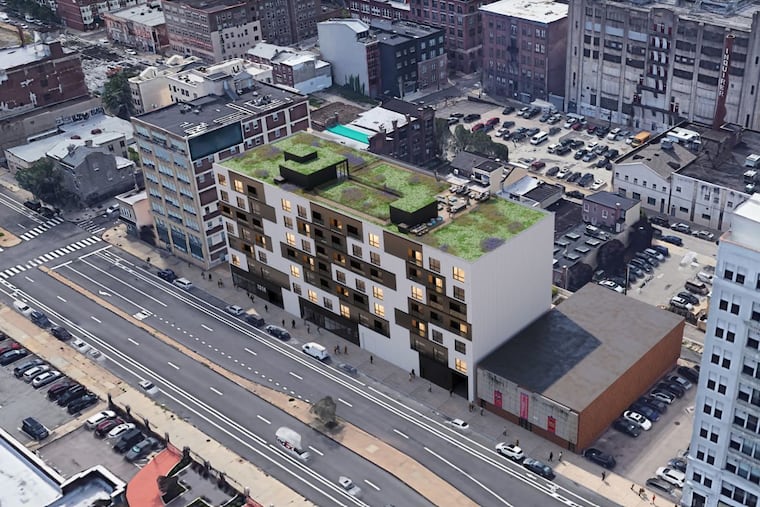New plan on Spring Garden Street: Apartments instead of self-storage units
A previous redevelopment plan had proposed building a self-storage facility on the same site in Philly's Callowhill neighborhood.

A 149-unit apartment building is planned on Spring Garden and 13th Streets, replacing a surface parking lot in a corner of the Callowhill neighborhood marked by lunar expanses of concrete.
The project comes from Volumetric Building Cos. (VBC), a Philadelphia-based company that constructs sections of its buildings in its factory and then installs them in the field. The company says the method reduces the cost of labor and time of construction in a way that will be passed on to consumers.
“Market-rate multifamily targets higher income earning bracket, 80th percentile and above,” said Michael Palmer, head of strategy and real estate for VBC. “We are designing for the core tenant population of Callowhill, which is in the 50th-to-70th percentile. We’ll be bringing units into this market at rents well below the neighborhood’s 2017 median rents.”
Palmer wasn’t able to offer an exact price range because leasing won’t begin until mid-2024 at the earliest.
The seven-story building, located at 1314 Spring Garden St., will include more than 1,000 square feet of fitness space and almost 1,600 square feet of retail, which VBC would prefer to be a small commercial business as opposed to a large-scale restaurant.
The building will sit almost on top of the Broad Street Line’s Spring Garden station and have 28 parking spaces and storage for 60 to 80 bicycles. It is a short walk from the Rail Park and a bit of a longer hike to Chinatown’s restaurants or City Hall.
The site has had two failed redevelopment efforts in the last decade. The most recent, in 2018, was a self-storage facility proposal that the zoning board allowed to proceed over the objections of the Planning Commission, the Callowhill Neighborhood Association, and Councilmember Mark Squilla.
The case ended with the city suing its own zoning board, essentially for granting a variance that allowed the project to proceed.
VBC’s proposal got a very different review from the neighborhood.
“We were excited to have an active use that brings people to the neighborhood, rather than a self-storage facility or the existing parking lot,” said Vincent DiMaria, head of the zoning committee for the Callowhill Neighborhood Association. “We were all pretty excited about the density of it.”
DiMaria noted that even the handful of neighbors on Nectarine Street, directly behind the project, had praised the setback the developers included in their rear facade to allow light into that narrow block.
Palmer noted that VBC hopes to emit far less carbon both during the construction of the building and after it is built. They are using glazing and building materials that will allow the structure to consume less energy, while sourcing from environmentally friendly companies and including a green roof.
“By virtue of manufacturing the building, we’re cutting out a ton of waste that goes to the landfill from the construction process,” Palmer said. “We’re trying to achieve a 60-to-66% reduction in carbon” during construction.
The project requires no zoning approval but will appear before the advisory-only Civic Design Review board on April 4.